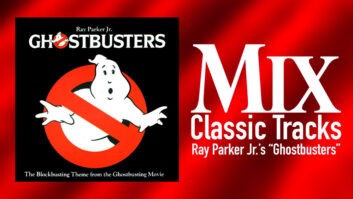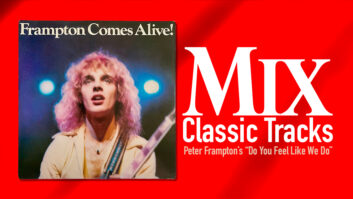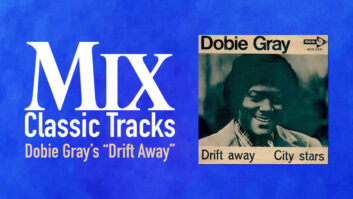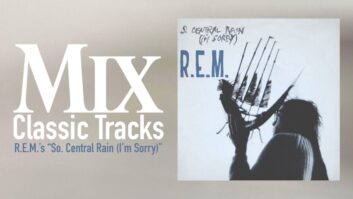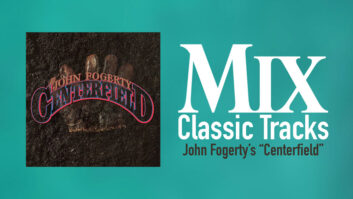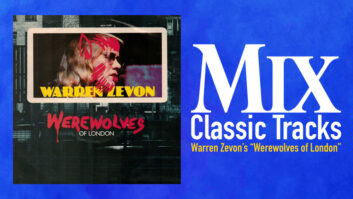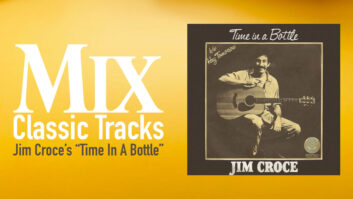When most of us think about Memphis music, we probably conjure the country blues singers and jug bands of the late ’20s and ’30s, or, even more likely, the immortal Stax and Hi Records soul acts of the ’60s and ’70s—Booker T., Otis Redding, Isaac Hayes, Rufus and Carla, Ann Peebles, Al Green, et al; it’s quite a list of certified hitmakers.
It’s always been a music town.
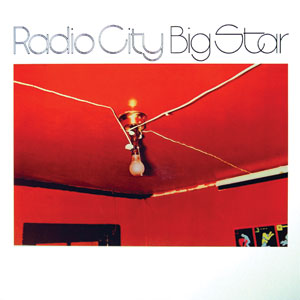 The early ’70s Memphis power-pop band Big Star never had anything close to a hit record, yet here we are writing about them in Classic Tracks. Why? Because Big Star was a great band whose influence and importance have grown tremendously through the years. They were both the classic “band ahead of its time” and also “record-business victims.” At a time when rock was dominated by prog bands and ’60s holdovers enamored of endless guitar solos, Big Star played lean, economical pop-rock inspired by mid-’60s British Invasion bands (The Beatles, The Who, The Kinks), as well as American groups ranging from The Byrds to the Velvet Underground.
The early ’70s Memphis power-pop band Big Star never had anything close to a hit record, yet here we are writing about them in Classic Tracks. Why? Because Big Star was a great band whose influence and importance have grown tremendously through the years. They were both the classic “band ahead of its time” and also “record-business victims.” At a time when rock was dominated by prog bands and ’60s holdovers enamored of endless guitar solos, Big Star played lean, economical pop-rock inspired by mid-’60s British Invasion bands (The Beatles, The Who, The Kinks), as well as American groups ranging from The Byrds to the Velvet Underground.
Sadly, it wasn’t until well after Big Star broke up that they were “discovered” by the new wave of rock bands that popped up in the late ’70s. Listen to Big Star’s first two albums—#1 Record (1972) and Radio City (1974)—and you’ll hear music that presaged such bands as Tom Petty & the Heartbreakers, Dwight Twilley, The Romantics and so many others who hit the charts once the “power pop” genre came into vogue, and directly influenced later indie and alternative groups like R.E.M., The Bangles (who faithfully covered “September Gurls”), The Replacements, The Posies and many others.
The Replacements even cut a song called “Alex Chilton,” after one of the leaders of the original Big Star. However, you might know Chilton’s name from his teenage success as lead singer of the Memphis blue-eyed soul band the Box Tops, who had two ubiquitous hits in the late ’60s—“The Letter” and “Cry Like a Baby.” Chilton quit the Box Tops in 1970 and went to New York for a brief period, but soon came home to Memphis and joined a trio of local musicians who were calling themselves Icewater—guitarist/singer/songwriter Chris Bell, bassist Andy Hummel and drummer Jody Stephens. Bell worked occasionally as an engineer at John Fry’s Ardent Studios in Memphis, and he and Chilton had talked about working together for some time. When Chilton joined the others in 1971, they named their new band Big Star, and in the fall of that year went into Ardent to record their first album for Fry’s Ardent Records label, which, beginning in 1972, would be distributed by Stax. “At the time it seemed like the greatest opportunity in the world,” Fry says.
Fry had originally founded Ardent in his Memphis home when he was just a teenager, but opened a proper commercial facility in a storefront on National Street in 1966 (when he was 21), and it quickly became a magnet for many local producers, songwriters and bands. It also attracted considerable work from Stax Records.
“People often mention the British Invasion bands when they talk about Big Star,” comments drummer Stephens, who has been the marketing manager at Ardent Studios since 1987, “but the whole Stax thing was also a huge influence on us and affected the way we played music. Certainly [Stax drummer] Al Jackson had a profound effect on me.” That said, Stephens does cite Brits Ringo Starr, Keith Moon, John Bonham, Charlie Watts and Procol Harum’s B.J. Wilson as primary influences.
Ardent moved to its current location on Madison Avenue in Memphis a couple of days after Thanksgiving in 1971, so Big Star’s #1 Record was completed and mixed at the new purpose-built studio facility. It included two good-sized rooms—Studio A was 25x40x18, Studio B 25x30x18. A gearhead from way back, Fry had equipped his studios with some of the finest equipment of the day. At the heart of both control rooms were custom Auditronics consoles built by Welton Jetton (who died in March 2014) using Spectrasonic amplifiers and equalizers. Studio A’s board had 24 inputs, Studio B’s 20. Besides using the console’s excellent pre’s and EQ, Fry and other engineers who worked at Ardent availed themselves of various outboard pieces, including Pultec EQ and a range of compressor/limiters such as the UA 176 and some early models from the British company Audio & Design Recording.
The studio also had three live echo chambers and three EMT plates (two with vacuum tube amplifiers, one solid-state). “I’d hog the echo,” Fry says with a chuckle. “I’d probably have all six of those things at least on standby when I mixed. I’d usually set one EMT short, one medium and one long; same with the chambers. Then we’d also often use pre-delay. In those days, if you wanted to do pre-delay on the echo, guess what—you had to roll another tape machine, because there was no such thing as a delay line yet.”
During Big Star’s early ’70s heyday, Ardent had 3M M56 16-track recorders “and we had Dolby A for the multitracks and the 2-tracks,” Fry says. “I guarantee you, those Big Star recordings, especially some of the acoustic stuff, would not be as quiet without the Dolby.”
There were two iso rooms off each of the two studios, though Big Star always recorded basic tracks with all the musicians in the same room, rather than isolating the drummer or vocalist—in fact, Fry says that Big Star would never lay down scratch vocals when they were cutting basics, “so I would never have any idea what any of the songs were about until later, when they’d do the vocals. But just hearing the tracks I could tell they were great songs.” Did he isolate the drums on the floor? “No, but we might put the guitar amps baffled off to the side. We’ve gone back to some of the Big Star multitracks for reissues, and I was really surprised how little bleed there was.”
For mics in that period, Ardent had “lots of Neumann condensers—M 249, U 64, U 67, KM 84—and a good range of dynamics: some Beyer models that were very durable, like the 201, and also [Electro-Voice] RE20s and [Sennheiser] 421s.” Without mentioning specific models, Fry says he always used four mics on drummer Stephens: “kick; snare, which also got the hi-hat; an overhead that would get the [mounted] toms; and one for the floor tom that would also get the ride cymbal.” Guitar amps would take a single mic—usually an RE20 or a 421—and bass would get two tracks—miked amp and DI. Fry says his favorite vocal mics were the M 249 and the U 67.
Classic Tracks: Todd Rundgren’s “Hello It’s Me”
For #1 Record, Big Star was a solid quartet, with Bell and Chilton co-writing all the songs except one, and alternating lead vocals. According to both Fry and Stephens, however, Bell was the driving force in the band during those sessions at Ardent in terms of production and arrangement ideas (not surprising, considering his extensive studio experience). As Stephens notes, “Chris was an engineer and really knew the studio well. He would hang out there for hours, trying things. I think that’s part of how he got those brilliant guitar sounds. But both Chris and Alex spent a lot of time working on their guitar parts and sounds.”
Despite containing several brilliant songs (the best-known of which is probably Chilton’s “Thirteen”) and garnering enthusiastic reviews and predictions for success, #1 Record was a commercial failure, doomed by Stax’s inability to distribute the album, even after they signed a distribution pact with larger Columbia Records. Bell quit Big Star in the fall of ’72, and the group very briefly disbanded before reforming as a trio (without Bell) for their second album, Radio City, which is the source of this month’s Classic Track, “September Gurls.”
“Chris and Alex had written some songs together for the second album before Chris split,” Stephens remembers, “but ‘September Gurls’ was Alex’s. He brought it in finished, and it was pretty much realized by the second or third time we went through it.” As on the first album, the basics were cut live—“I don’t think we ever went beyond three takes on either album,” Fry says. “They were always well-rehearsed and knew exactly what they wanted to play.”
Not surprisingly, Chilton carried more of the load in terms of both songwriting and production on Radio City, though in general, it has a rougher, less-produced quality. “I think Alex was brilliant to really understand what a three-piece band was, and Radio City is very much a three-piece record,” Stephens adds. “It’s not full of overdubs and lush harmonies like #1 Record. Chris was definitely more into production, and Alex was maybe a little bit more into spirit—into the base feel of things.”
“September Gurls” does have two Chilton guitar parts on it—the chiming main Fender rhythm part and overdubbed Vox Mando-guitar line. Stephens’ whomping drums have a visceral Keith Moon feel to them, and Hummel’s bass is solid with some nicely ornamental moments. Chilton’s high, clear lead vocal has an almost wistful quality, and the harmonies have a touch of Byrds-ish beauty. It’s power-pop magic in under three minutes. As Fry says, “I sure did think at the time that if we were going to have a radio hit, that would be it. But it wasn’t. That’s part of the marksmanship of the music industry. All the difficulties Stax was having were becoming very evident, and whatever marketing and promotion efforts we had were in shreds by the time the record came out.”
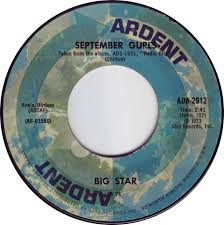 Distributor Columbia all but ignored Radio City, too, when it was released in February 1974, so once again Big Star was left wondering what had happened. “We’d done what we could as a band,” says Stephens philosophically. “The rest was up to everybody else.” By year’s end, Big Star had disbanded.
Distributor Columbia all but ignored Radio City, too, when it was released in February 1974, so once again Big Star was left wondering what had happened. “We’d done what we could as a band,” says Stephens philosophically. “The rest was up to everybody else.” By year’s end, Big Star had disbanded.
Chris Bell was killed in a car wreck in 1978, the same year EMI released a double-record set of the first two Big Star albums, to great critical acclaim. Chilton and Stephens formed a new Big Star with two members of The Posies in 1993, and they built a good head of steam touring periodically until Chilton died of a heart attack in 2010. Four months later, original bassist Andy Hummel died of cancer. Stephens and John Fry are still working at Ardent and helping maintain Big Star’s still-growing legacy. Cool band. Check ’em out if you haven’t.

